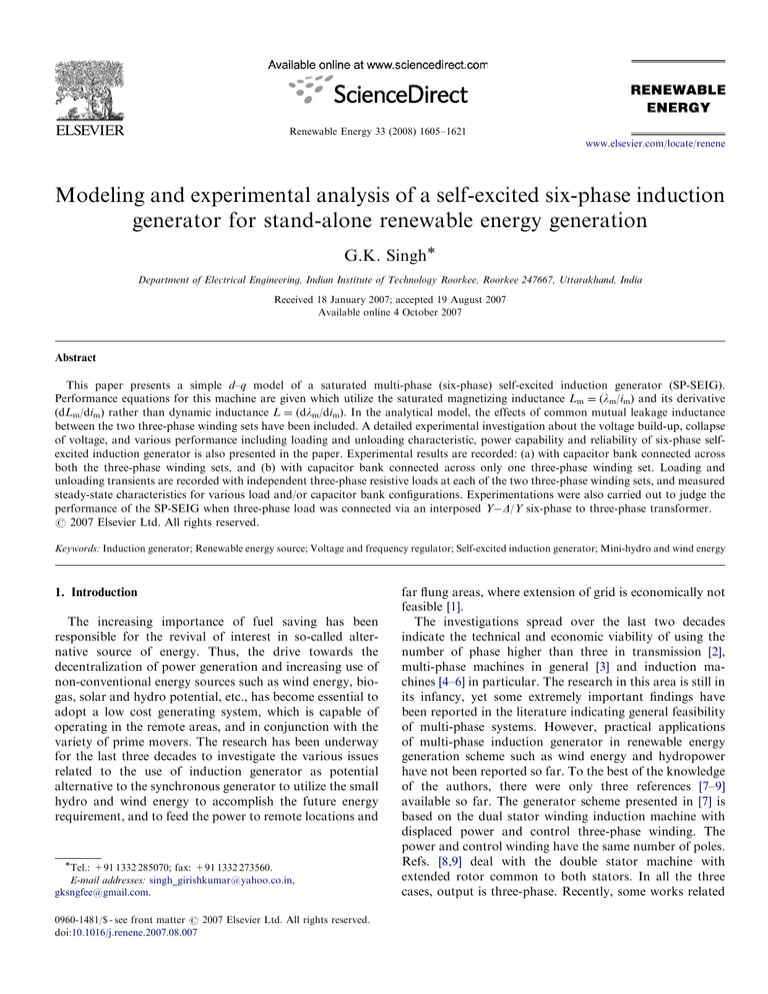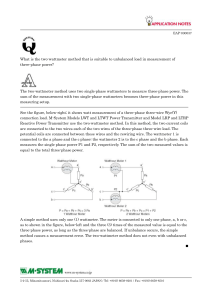
ARTICLE IN PRESS
Renewable Energy 33 (2008) 1605–1621
www.elsevier.com/locate/renene
Modeling and experimental analysis of a self-excited six-phase induction
generator for stand-alone renewable energy generation
G.K. Singh
Department of Electrical Engineering, Indian Institute of Technology Roorkee, Roorkee 247667, Uttarakhand, India
Received 18 January 2007; accepted 19 August 2007
Available online 4 October 2007
Abstract
This paper presents a simple d–q model of a saturated multi-phase (six-phase) self-excited induction generator (SP-SEIG).
Performance equations for this machine are given which utilize the saturated magnetizing inductance Lm ¼ (lm/im) and its derivative
(dLm/dim) rather than dynamic inductance L ¼ (dlm/dim). In the analytical model, the effects of common mutual leakage inductance
between the two three-phase winding sets have been included. A detailed experimental investigation about the voltage build-up, collapse
of voltage, and various performance including loading and unloading characteristic, power capability and reliability of six-phase selfexcited induction generator is also presented in the paper. Experimental results are recorded: (a) with capacitor bank connected across
both the three-phase winding sets, and (b) with capacitor bank connected across only one three-phase winding set. Loading and
unloading transients are recorded with independent three-phase resistive loads at each of the two three-phase winding sets, and measured
steady-state characteristics for various load and/or capacitor bank configurations. Experimentations were also carried out to judge the
performance of the SP-SEIG when three-phase load was connected via an interposed YD/Y six-phase to three-phase transformer.
r 2007 Elsevier Ltd. All rights reserved.
Keywords: Induction generator; Renewable energy source; Voltage and frequency regulator; Self-excited induction generator; Mini-hydro and wind energy
1. Introduction
The increasing importance of fuel saving has been
responsible for the revival of interest in so-called alternative source of energy. Thus, the drive towards the
decentralization of power generation and increasing use of
non-conventional energy sources such as wind energy, biogas, solar and hydro potential, etc., has become essential to
adopt a low cost generating system, which is capable of
operating in the remote areas, and in conjunction with the
variety of prime movers. The research has been underway
for the last three decades to investigate the various issues
related to the use of induction generator as potential
alternative to the synchronous generator to utilize the small
hydro and wind energy to accomplish the future energy
requirement, and to feed the power to remote locations and
Tel.: +91 1332 285070; fax: +91 1332 273560.
E-mail addresses: singh_girishkumar@yahoo.co.in,
gksngfee@gmail.com.
0960-1481/$ - see front matter r 2007 Elsevier Ltd. All rights reserved.
doi:10.1016/j.renene.2007.08.007
far flung areas, where extension of grid is economically not
feasible [1].
The investigations spread over the last two decades
indicate the technical and economic viability of using the
number of phase higher than three in transmission [2],
multi-phase machines in general [3] and induction machines [4–6] in particular. The research in this area is still in
its infancy, yet some extremely important findings have
been reported in the literature indicating general feasibility
of multi-phase systems. However, practical applications
of multi-phase induction generator in renewable energy
generation scheme such as wind energy and hydropower
have not been reported so far. To the best of the knowledge
of the authors, there were only three references [7–9]
available so far. The generator scheme presented in [7] is
based on the dual stator winding induction machine with
displaced power and control three-phase winding. The
power and control winding have the same number of poles.
Refs. [8,9] deal with the double stator machine with
extended rotor common to both stators. In all the three
cases, output is three-phase. Recently, some works related
ARTICLE IN PRESS
1606
G.K. Singh / Renewable Energy 33 (2008) 1605–1621
2. Mathematical model
2.1. Modeling of saturated self-excited induction generator
A schematic representation of the stator and rotor
windings for a two pole, six-phase induction machine is
given in Fig. 1. The six-stator phases are divided into two
wye-connected three-phase sets, labeled abc and xyz (called
set I and II, respectively), whose magnetic axes are
displaced by an arbitrary angle a. The windings of each
three-phase set are uniformly distributed and have axes
that are displaced 1201 apart. The three-phase rotor
windings ar, br, cr are also sinusoidally distributed and
have axes that are displaced by 1201 apart. In developing
the equations, which describe the behavior of a multi-phase
machine, it is assumed that there is no physical fault
propagation from one three-phase set to other three-phase
set as neutral of both the stator winding sets are separate.
The following voltage equations of a multi-phase induction
machine in arbitrary reference frame [13,14] are
vq1 ¼ r1 iq1 þ ok ld1 þ plq1 ,
(2.1)
q-axis
b-axis
n
tio
ta
ro
to the six-phase self-excited induction generation have been
reported by Singh et al. [10–12]. Ref. [10] deals with the
modeling and analysis of six-phase self-excited induction
generator, however, dynamic cross saturation has not been
considered in this paper. In Refs. [11,12], analysis and
practical feasibility of the SP-SEIG are included.
This paper, therefore, presents the mathematical modeling of a saturated six-phase self-excited induction generator
taking into account the dynamic cross saturation (different
as given in Ref. [11]). A detailed experimental investigation
about the voltage build-up, collapse of voltage, and various
performance including loading and unloading characteristic, power capability and reliability of six-phase selfexcited induction generator is also presented in the paper.
Experimental results are recorded: (a) with capacitor bank
at each of the two three-phase windings, and (b) with only
one capacitor bank. Loading and unloading transients are
recorded with independent three-phase resistive loads at
each of the two three-phase winding sets, and measured
steady-state characteristics for various load and/or capacitor bank configurations. Experimentations were also
carried out to judge the performance of the SP-SEIG
when three-phase load was subjected through an interconnecting YD/Y six-phase to three-phase transformer.
Since the conventional supply and uses are three, it
seems necessary to mention here that the generator can
supply two separate three-phase loads, which represents an
additional advantage. Last but not the least, outputs of the
two three-phase windings can be used to supply a single
three-phase load through an interconnecting six-phase to
three-phase transformer, in which case failure of one threephase winding does not lead to the system shutdown and
the load can be still supplied from the remaining healthy
winding.
br-axis
r
x-axis
y-axis
ar-axis
r
a-axis ----- d-axis
c-axis
cr-axis
z-axis
Fig. 1. A two-pole six-phase induction machine with a0 displacement
between two-stator winding sets.
vd1 ¼ r1 id1 ok lq1 þ pld1 ,
(2.2)
vq2 ¼ r2 iq2 þ ok ld2 þ plq2 ,
(2.3)
vd2 ¼ r2 id2 ok lq2 þ pld2 ,
(2.4)
0 ¼ rr iqr þ ðok or Þldr þ plqr ,
(2.5)
0 ¼ rr idr ðok or Þlqr þ pldr ,
(2.6)
where ok is the speed of the reference frame, p denotes
differentiation w.r.t. time, or is the rotor speed, and all
other symbols have their usual meaning. Here, rotor
quantities are referred to stator. The expressions for stator
and rotor flux linkages are
lq1 ¼ Ll1 iq1 Llm ðiq1 þ iq2 Þ þ Ldq id2
þ Lmq ðiq1 iq2 þ iqr Þ,
ð2:7Þ
ld1 ¼ Ll1 id1 Llm ðid1 þ id2 Þ Ldq iq2
þ Lmd ðid1 id2 þ idr Þ,
lq2 ¼ Ll2 iq2 Llm ðiq1 þ iq2 Þ þ Ldq id1
þ Lmq ðiq1 iq2 þ iqr Þ,
ð2:8Þ
ð2:9Þ
ld2 ¼ Ll2 id2 Llm ðid1 þ id2 Þ þ Ldq iq1
þ Lmd ðid1 id2 þ idr Þ,
ð2:10Þ
lqr ¼ Llr iqr þ Lmq ðiq1 iq2 þ iqr Þ,
(2.11)
ldr ¼ Llr idr þ Lmd ðid1 id2 þ idr Þ,
(2.12)
where Llm is the common mutual leakage inductance
between the two sets of stator winding and Ldq is the
cross-saturation coupling between the d- and q-axis of
ID
302669
Title
Modelingandexperimentalanalysisofaself-excitedsix-phaseinductiongeneratorforstand-alonerenewable
energygeneration
http://fulltext.study/article/302669
http://FullText.Study
Pages
17





